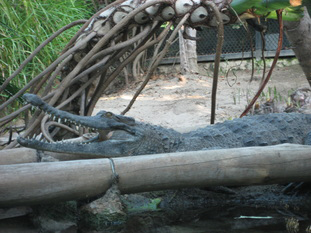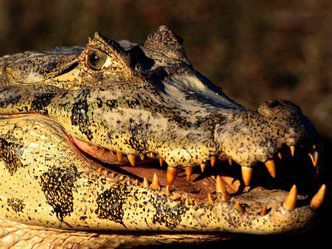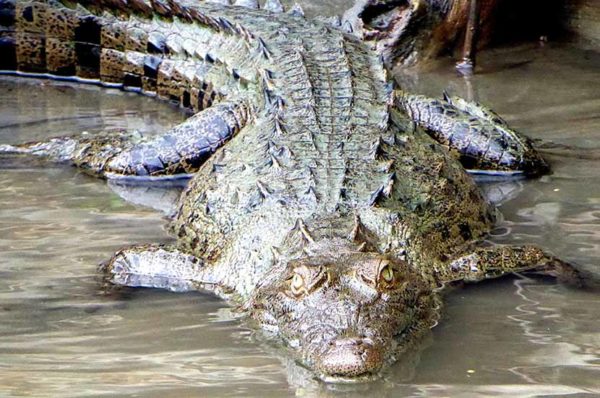
Spectacled Caimans, also called White or Common Caimans, have become one of the most popular crocodilians kept in captivity due to their smaller size and availability. In the state of Illinois caimans are classified as dangerous by to a Supreme Court ruling. Prior to obtaining this species, check with your local municipal government for regulations against exotic animals as pets and with your state government for licensing. In order to gain a license you must prove you can accommodate the species, have experience handling the species, and also are fluent in the husbandry requirements. The power of this species should never be underestimated! Although they are smaller in maturity than an alligator or crocodile they can cause severe injury if not properly handled and respected. This is at least a 15-year commitment and a hefty financial and spatial investment as well.
Reptile rescues and local zoos are constantly asked to accept relinquished Spectacled Caimans and most no longer accept these animals. Please, consider adopting an adult or juvenile from a reptile rescue.
Natural History
The Spectacled Caiman is found primarily throughout the wetland areas of Central and South America with some isolated communities found in the most southern part of Florida’s peninsula due to illegal release and accidental escapes. All caimans are listed under Appendix I or II of CITES. CITES is an international trade agreement and not a declaration of conservation status. Chicago Exotics always recommends that owners research the natural habitat of any species they are looking to obtain as well as visiting a local zoo or facility with the desired species.
Description
Spectacled Caimans are easily identified by their pointed snouts, proportionately shorter tail than alligators, and the infraorbital ridge along the head. A fully grown male caiman is still smaller than the American Alligator or any of the various crocodiles but will still reach lengths of 6.5-8 feet in length. This species can be particularly aggressive and nervous. If a smaller-sized caiman is ideal a Curvier’s Dwarf Caiman may be a better option. The Curvier’s Dwarf reaches about 5 feet in length but is very territorial. Regardless of species, individual tempers will vary.
Expenses
Expenses to consider before obtaining your caiman are housing requirements, food, veterinary visits, license and permits, insurance rates, and personal medical bills. Housing can start with a huge aquarium and end with a full room or part of the basement converted for the needs of your caiman. Housing takes into account the amount of water used, the cost of heating an enclosure both in and out of the water, running and maintaining a filtration system and the replacement of substrate and furnishings. Food is always a cost concern for all animals and adult caimans are no exception! Adults will eat large amounts of food on a regular basis.
Veterinary visits should be planned in advance. If you are near Chicago Exotics Animal Hospital we will see your caiman but not all hospitals will. Find a veterinarian who will work with you and your pet as well as a friend or family member who will help you move your 7-foot pet. Licensing and permits typically come with an administrative fee and renewal of these documents has a fee as well. Check with your state for prices and requirements. In many areas, insurance rates on your home will increase with the acquisition of a dangerous animal. Also, consider the money required for your own medical bills as accidents do occur. It is better to be safe than sorry.

Enclosures
Hatchlings and small juveniles can generally be kept in large glass aquariums so long as ample hiding places and a land area is available. Small hatchlings do well in 20 gallon long tanks and year-olds need at least a 55 gallon tank. Plants or a background sheet of plants should be adhered to the back for extra security. A terrarium may be a better option due to front and top closure. A front opening cage makes it easier to access during maintenance, feeding, and medical treatments. Some find that hatchlings can be grown in a 5 foot round plastic pool as long as a cover, and land area is provided along with the other necessary amenities.
Ideally, the water and land area should both be spacious and a minimum of 3-4 times the total length of the animal being kept in it. A caiman up to 4 feet in length can utilize a giant water land tub without difficulty although the expense is rather high. An adult enclosure will ideally be 6’ x 8’ land and 8’ x 10’ x 3’ water. If a substrate is desired for the water area, use gravel rather than sand. This is preferable only for larger specimens. An outdoor enclosure for at least part of the year during appropriate weather is recommended with concrete ponds being an excellent option. However, lining, filtration, heating, and circulation are all to be considered before creating a permanent enclosure. Large pond kits are available and many forums have further information on creating large permanent and temporary pond side enclosures.
A good filter is a must for this species. They will foul up the water quickly and daily water changes become tiresome. A good investment is a Fluval or an Eheim water filter to start. Each of these filters are measured by the capacity of water pumped in total volume per hour. For example, the Eheim 440 will pump 440 liters of water an hour. Chicago Exotics recommends the use of multiple filter media that will allow biological, manual, and chemical filtration. An under-gravel filter removes sediment and helps keep any substrate the tank cleaner. Water changes should be performed weekly to prevent the build up of ammonia, nitrites, and bacteria. The water should be deep enough at the deep end of the enclosure for total body immersion.
All furnishings no matter how small must be secure! Rock formations are best created on a frame and held together with a waterproof non-toxic epoxy. The frame will allow for easy removal during maintenance while insuring all stones are securely held in place and not in your caiman’s gastrointestinal tract. Hides must be provided for hatchlings due to their shy nature. Juveniles and adults benefit from appropriate hiding areas as well. Hatchlings are notorious for not eating well. Coverage is important, especially coverage that prevents caiman from seeing the owner.
The preferred body temperature for Spectacled Caimans is around 84-93 degrees Fahrenheit. As with all reptiles, a thermal gradient is necessary to allow the animal a full range of natural behaviors and to allow proper thermoregulation. The enclosure should be kept in a semi-tropical state with the spatial temperature being warm and the relative humidity moderately high. During the day, spatial temperatures should be around 97 degrees Fahrenheit and the night temperatures dipping no lower than 68 degrees Fahrenheit. Spatial temperatures should never reach over 104 degrees Fahrenheit! Water is typically maintained at 81 to 88 degrees Fahrenheit.
At least one basking area between 91 and 93 degrees Fahrenheit is required to maintain a proper thermal gradient. Always measure the temperature of the basking area several inches above the substrate. Incandescent bulbs will heat the air as will ceramic heat emitters (CHE). During the night, a light is not required.
The typical light cycle for your caiman should be between 11 to 13 hours of day light followed by 11-13 hours of darkness. Some keepers believe a night light will simulate the moon but is not recommended and found unnecessary. If a light is required at night to maintain appropriate temperatures, use a blue or red incandescent bulb or a CHE for heat. Ultraviolet lighting is recommended and strongly urged for all reptiles by Chicago Exotics. A 2.0 UVB for adults and a 5.0 UVB for hatchlings and juveniles is a great addition to your enclosure and will provide natural lighting as well as physical and psychological benefits. UVB has been found to increase inquisitiveness, increase feeding response and decrease stress. UVB does not go through plastic or glass so it is essential to mount your UVB where it will be effective. Keep all lights out of the caiman’s vertical jumping reach! Bulbs must be protected with bars or caging if they are within jumping distance.
Small to medium sized enclosures can be heated using a submersible aquarium heater. Typically, the formula is 1 watt / 1 liter of water. These heaters however are not fool proof and require a thermostat to insure the water temperature does not rise above 88 degrees Fahrenheit. Small bodies of water generally benefit from the use of a hemofilter which heats and acts as a filter at the same time.
Protect all heating elements, piping, cords, etc from curious mouths and devastating claws by using an inverted and secured ceramic pot. A layer of securely fastened slate or shale is also effective and better used in those larger enclosures for adults and juveniles.
Larger enclosures are required by law to have GFCI (ground-fault circuit interruption) which is designed to save lives by interrupting the electricity flow if a living thing acts as a conductor between an energized surface and the ground. As the size of the enclosure continues to grow, so will the heating element requirements. Under tank heaters as well as heated pipes along the floor connected to a larger heat source may be utilized in the future enclosures of your pet. No matter what size enclosure you are heating, all heating elements should be connected to a thermostat for safety.
All uneaten food should be removed as soon as possible from the water and land area to prevent the build up of bacteria. Spot cleaning of feces should be performed daily and the land area thoroughly cleaned every 1-2 weeks. Protein skimmers or a bucket can be used to remove the protein layer on the top of the water as it appears. This is uncommon in freshwater enclosures but may still be needed. Furnishings and tools can be disinfected and soaked in Chlorhexidine at a dilution of 1:10 for 30 minutes. Bleach should be used with extreme caution at a dilution of 1:30 (roughly ½ cup to a gallon of water). Rinse thoroughly and allow to air dry completely prior to reintroduction into the enclosure. Glass portions of the enclosure should be washed with diluted white vinegar.
When performing maintenance in the enclosure, always remove the caiman even if they are only a hatchling. Most injuries occur during feeding and general maintenance. Place hatchlings and young juveniles in a storage tub with a towel over the top to reduce stress. Small to medium caimans can be moved around their enclosure by use of a wooden shield. If using a shield, please do not hold it by the edges! Affix a handle to the back of the shield to protect your fingers.
A more in depth hand out on complex and larger aquatic enclosures will be available in the future. For now, consult reptile forums listed below in the “Sources and Suggested Reading” section for more information and advice on building such in depth enclosures.
Handling
Handling of your caiman should only be done as necessary. These animals are aggressive and incredibly nervous. Hatchlings and young juveniles will often lay limp and “sedate” across an owner’s lap or in their arms. This is a fear response and should not be confused with contentment like you would see in a dog or cat. There are risks to handling these animals, even with training and proper restraint. The jaws are incredibly powerful especially upon closing. Once the jaws are closed they are hard to dislodge or re-open. Claws and osteoderms are potentially dangerous and lead to lacerations on hands and arms. Always wear thick leather gloves and eye protection when handling you caiman and never try to handle a large animal by yourself.
Very young caimans will produce a loud distress call when handled. Handling acclimates very young animals to restraint which in the future will come in handy for maintenance and veterinary procedures. Some caimans may grow calmer and become less inclined to bite if handled frequently while young. This however varies with the caiman and its temperament. The mouth should be taped any time the individual is handled for safety.
Small caimans can be handled by placing a hand behind the head and at the base of the tail using your arm to support the body. Juveniles should be handled with your hand securely behind the head or tail with your arm underneath for support. The caiman should have its tail pinned to your body with your arm. Another method is to have your hand underneath the chest with the tail pinned against your body. The two handed approach to handling is to place one hand behind the head and the other at the base of the tail. Larger caimans require training and team work.
Feeding
Whole prey animals help to ensure a balance is maintained in the diet. A variety of whole prey foods should be offered to maintain the balance. The muscle is protein and the bones of the prey item are full of calcium. Lean meat pieces are commonly available for captive feeding and must be supplemented with calcium. Fish in general are good to feed with fresh fish being desired over defrosted fish. Fresh fish have a higher level of thiaminase. Thiaminase destroys thiamine (B1) and therefore thiamine (B1) must be supplemented. Warming the fish to 176 degrees Fahrenheit denatures the enzyme but can break down other essentials in the prey item. Ocean perch does not contain thiaminase and is an excellent addition to a diet. Oily fish can create a vitamin E deficiency and should be avoided or supplemented with vitamin E. This deficiency creates nodular lesions through out the body cavity and within fat pads as well. The diet will need to be changed as well as supportive care administered if this occurs.
Mice and rats are excellent starter foods. Add meat with the bone to the diet along with snails, crayfish, and frogs. Worms used for composting can be deadly and non-composting earth worms must be purchased with that in mind. Hatchlings have a fragile gastrointestinal system and find the chitin in insect exoskeletons hard to digest. An added safety measure is to squeeze the dirt from each earthworm if fed. Hatchlings do well on finely chopped whole food in a plate. This will create a huge mess but will increase digestibility of the food.
Mazuri brand crocodile food is an excellent addition to a whole prey diet. Chicago Exotics recommends the use of whole prey supplemented with Mazuri crocodile food.
Hatchlings should be fed every 2 days. Juveniles should ideally be fed 2-3 times a week and adults 1-2 times a week. Obesity is a huge problem in captivity as caimans live to eat. Always remove uneaten food after 10 to 15 minutes. It is rare for a juvenile or adult caiman to refuse food. Hatchlings are nervous with feedings and may not readily eat. This is not uncommon. Never harass a hatchling with food. Try raising the water to 86 degrees Fahrenheit, leave the room, or improve the amount of coverage available. Trying multiple types of food has proven successful in the past.
Common Medical Problems
Hypothermia – Caused by inappropriately cold water or spatial temperature. This will cause your caiman to list to the side while swimming and can result in drowning. Decreased appetite, decreased or no fecal production and listlessness are all common signs. Correct the temperature and take your caiman to a veterinarian for evaluation of possible secondary disease processes. Call Chicago Exotics or your veterinarian for an exam and treatment.
Dernatophilosis – Caused by Dermarophilus sp (a bacteria). Brown to red lesions on the skin at the junction of the ventral abdominal scales and ulcers are common signs. Prevention is the key with a focus on intense hygiene. Call Chicago Exotics or your veterinarian for an exam and treatment.
Upper Respiratory Disease – This can be caused by many different fungi, bacteria, and viruses. Signs are typically lethargy, weakness, decreased appetite, nasal secretion, excessive basking, abnormal swim patterns, and white ocular (eye) discharge. Call Chicago Exotics or your veterinarian for an exam and treatment.
Neurological Issues – These are typically related to abnormal swim behaviors as well as lethargy, loss of coordination, head tilts, muscle tremors, and anorexia. This can be caused by hypoglycemia or increased ammonia in the enclosure (oxygen depletion). Call Chicago Exotics or your veterinarian for an exam and treatment.
Skin Issues – These usually result from poor water quality, inappropriate temperatures and stress. Secondary bacterial and fungal skin infections occur. When feeding meat, fat will create a slime layer on the walls and water surface and will adhere to the skin. Improve the overall hygiene of the enclosure, the water quality, and stabilize temperatures. Call Chicago Exotics or your veterinarian for an exam and treatment.
Sources and Suggested Reading
- Captive Crocodilians: Unusual Cases and Common Diseases, Javier G. Nevarez, DVM PhD NAVC Conference 2010
- A Field Guide to Reptiles and the Law, John P. Levell
- A Petkeepers Guide to Reptiles and Amphibians, David Alderton
- The Ultimate Guide to Crocodilians in Captivity, Christopher T. Dieter
- Illinois Department of Conservation – www.state.il.us – (217) 782-6302
- Crocodilian Care – www.crocodilian.com (A Must Read!)
- Caiman Hunter Rescue – www.caimanhunter.com
- S and S Exotic Animals, Inc – www.sandsexoticanimals.com
- King Snake Forums – www.kingsnake.com
- Reptile Forums of England – www.reptileforums.co.uk
- Reptile Community Forum – www.reptile-community.com
- Reptic Zone Forum – www.repticzone.com

